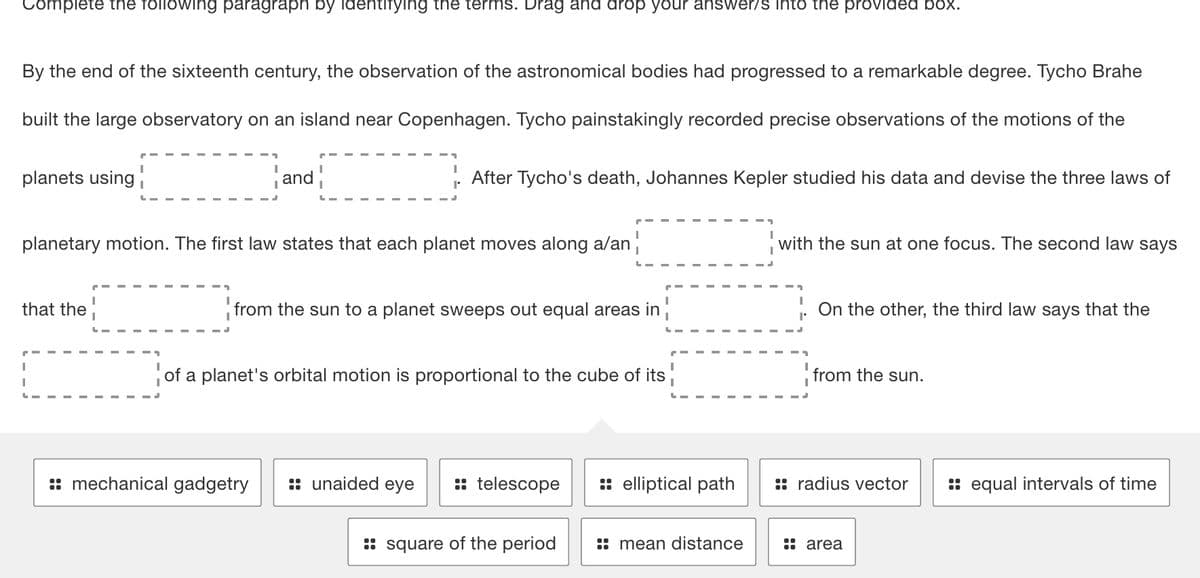Complete the following paragraph by identifying the terms. Drag and drop your answers into the provided box. By the end of the sixteenth century, the observation of the astronomical bodies had progressed to a remarkable degree. Tycho Brahe built the large observatory on an island near Copenhagen. Tycho painstakingly recorded precise observations of the motions of the planets using that the and planetary motion. The first law states that each planet moves along a/an After Tycho's death, Johannes Kepler studied his data and devise the three laws of from the sun to a planet sweeps out equal areas in :: mechanical gadgetry of a planet's orbital motion is proportional to the cube of its unaided eye :: telescope square of the period :: elliptical path mean distance with the sun at one focus. The second law says 1. On the other, the third law says that the from the sun. radius vector area :: equal intervals of time
Complete the following paragraph by identifying the terms. Drag and drop your answers into the provided box. By the end of the sixteenth century, the observation of the astronomical bodies had progressed to a remarkable degree. Tycho Brahe built the large observatory on an island near Copenhagen. Tycho painstakingly recorded precise observations of the motions of the planets using that the and planetary motion. The first law states that each planet moves along a/an After Tycho's death, Johannes Kepler studied his data and devise the three laws of from the sun to a planet sweeps out equal areas in :: mechanical gadgetry of a planet's orbital motion is proportional to the cube of its unaided eye :: telescope square of the period :: elliptical path mean distance with the sun at one focus. The second law says 1. On the other, the third law says that the from the sun. radius vector area :: equal intervals of time
Glencoe Physics: Principles and Problems, Student Edition
1st Edition
ISBN:9780078807213
Author:Paul W. Zitzewitz
Publisher:Paul W. Zitzewitz
Chapter4: Forces In One Dimension
Section: Chapter Questions
Problem 80A
Related questions
Question

Transcribed Image Text:Complete the following paragraph by Identifying the terms. Drag and drop your answer/s into the provided box.
By the end of the sixteenth century, the observation of the astronomical bodies had progressed to a remarkable degree. Tycho Brahe
built the large observatory on an island near Copenhagen. Tycho painstakingly recorded precise observations of the motions of the
planets using
and
After Tycho's death, Johannes Kepler studied his data and devise the three laws of
planetary motion. The first law states that each planet moves along a/an
with the sun at one focus. The second law says
that the
from the sun to a planet sweeps out equal areas in
On the other, the third law says that the
of a planet's orbital motion is proportional to the cube of its
from the sun.
:: mechanical gadgetry
:: unaided eye
:: telescope
: elliptical path
:: radius vector
:: equal intervals of time
square of the period
:: mean distance
:: area
Expert Solution
This question has been solved!
Explore an expertly crafted, step-by-step solution for a thorough understanding of key concepts.
Step by step
Solved in 2 steps with 2 images

Knowledge Booster
Learn more about
Need a deep-dive on the concept behind this application? Look no further. Learn more about this topic, physics and related others by exploring similar questions and additional content below.Recommended textbooks for you

Glencoe Physics: Principles and Problems, Student…
Physics
ISBN:
9780078807213
Author:
Paul W. Zitzewitz
Publisher:
Glencoe/McGraw-Hill

University Physics Volume 1
Physics
ISBN:
9781938168277
Author:
William Moebs, Samuel J. Ling, Jeff Sanny
Publisher:
OpenStax - Rice University

Glencoe Physics: Principles and Problems, Student…
Physics
ISBN:
9780078807213
Author:
Paul W. Zitzewitz
Publisher:
Glencoe/McGraw-Hill

University Physics Volume 1
Physics
ISBN:
9781938168277
Author:
William Moebs, Samuel J. Ling, Jeff Sanny
Publisher:
OpenStax - Rice University